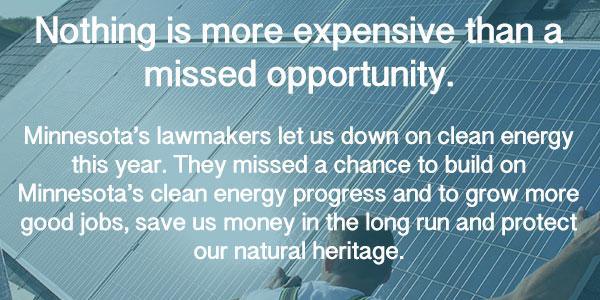by Michelle Rosier
What a difference a day makes (or in this case, two years.) In 2013, the Minnesota legislature passed clean energy and jobs policies that have set the stage for continued success in Minnesota’s growing clean energy economy and what Forbes magazine recognizes as the next gold rush for solar energy. While 2015 started with the potential to make important progress on clean energy, it ended with energy policies that primarily benefit utilities and large energy users while threatening investments in Minnesota’s clean energy transition. This legislative session did not live up to what Minnesotans expect from their leaders in helping the state continue to build a strong clean energy economy and transition beyond fossil fuels, like coal. You can read a summary of the different visions in the 2015 energy bills as proposed.

- Workers installing a solar array at CHS Field in St. Paul
Here’s what passed during the 2015 Special Session related to energy:
- Co-op and municipal utilities have the authority to charge customers with distributed generation (like solar, small wind) a fixed fee on their energy bills (sometimes called a “solar tax or penalty”), but they must first complete a study that shows a reasonable rationale for the fixed charge, before imposing it on their customers;
- Co-op and municipal utility customers with new 40 kilowatt or smaller distributed generation can elect to allow their utility to zero out their balance for energy sold to the grid at the end of the year; effectively donating the electricity to the utility and its other customers (net metering change added during the Special Session without a hearing);
- Energy intensive industries (like mines) are eligible for a reduced electric rate that will be paid for by increased electric rates for smaller businesses and homes (customers on energy assistance are exempt from this rate increase, and it only applies to Minnesota Power and Otter Tail Power customers);
- Utilities can file requests to change their customers’ rates that look out up to 5 years. A request over this extended timeline must include what investments the utility is planning to make on its system; including a look at the opportunities to save customers money with increased efficiency and microgrids;
- The Minnesota Pollution Control Agency must provide a draft of the state’s Clean Power Plan as of March 15, 2016 to the Legislature for review and comment. The Clean Power Plan is the nation’s first effort to reduce climate-disrupting carbon pollution from existing power plants and is credited with helping the United States negotiate carbon reduction commitments with China and Brazil;
- Allocates $150,000/year for weatherization programs to help homeowners on energy assistance purchase solar panels or other renewable technologies for their homes. (check out this great piece on solar, wind and efficiency as a solution to energy poverty.)
This is not an exhaustive list of the policies passed. The full language of the bill is here. And, check out Fresh Energy’s 2015 Legislative Overview.

- image credit: @mncleanenergy